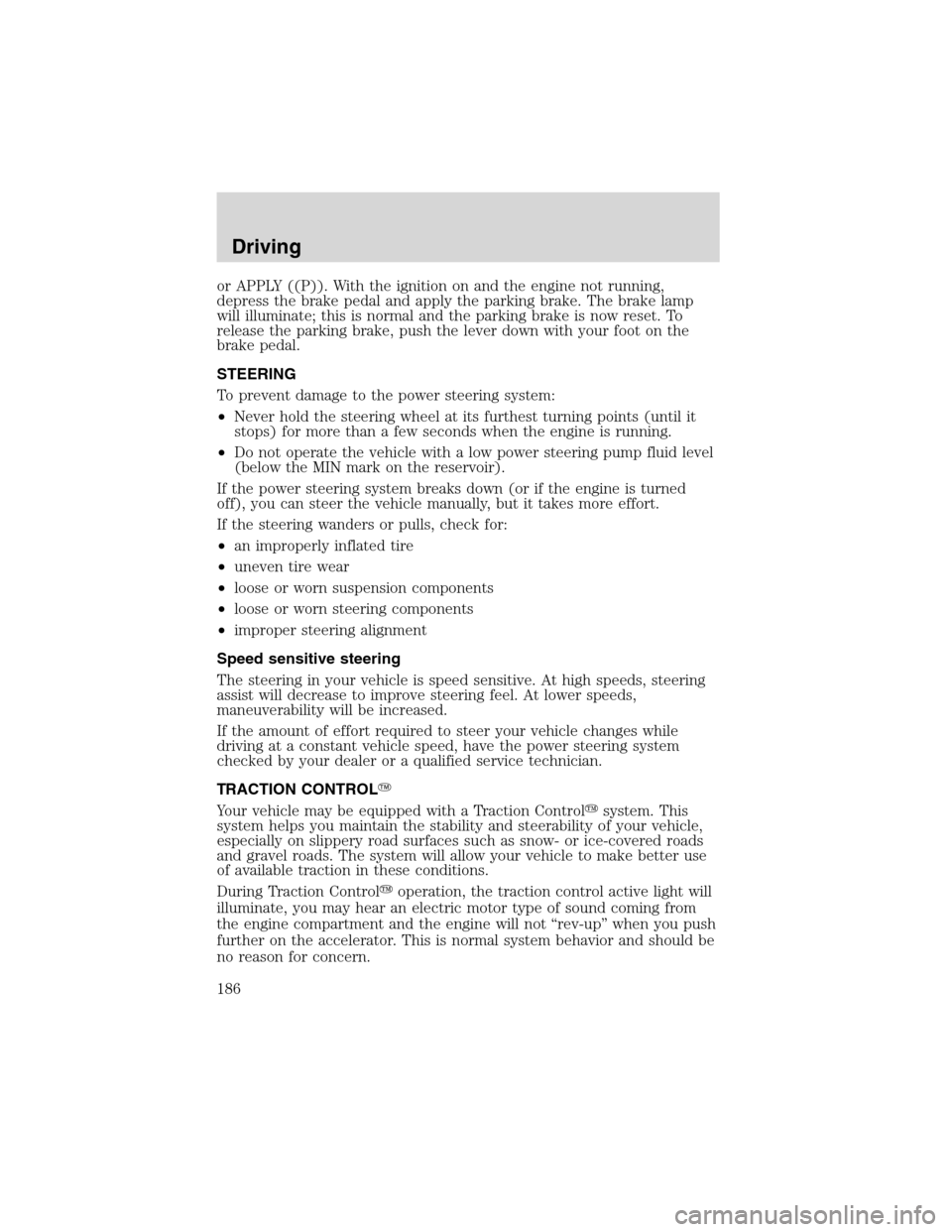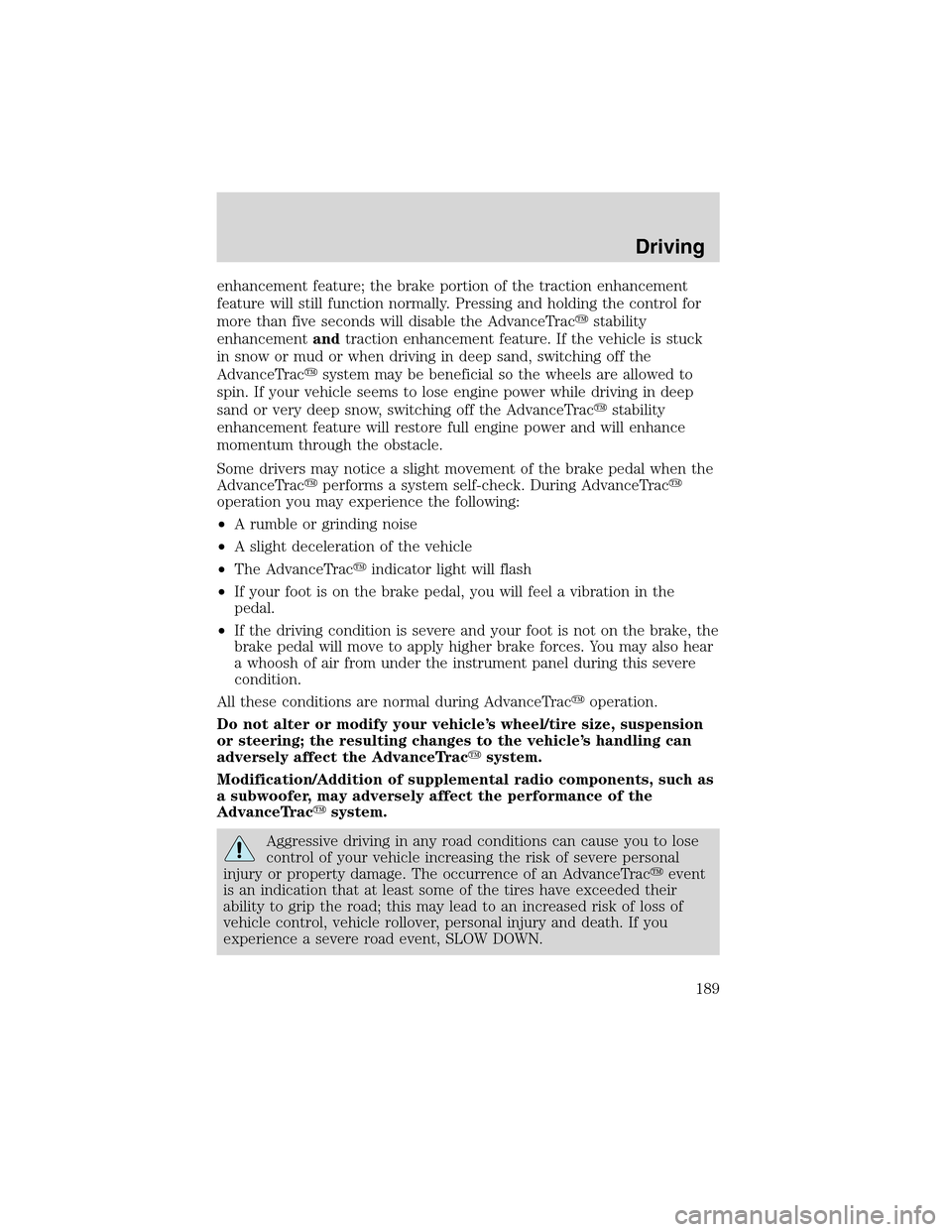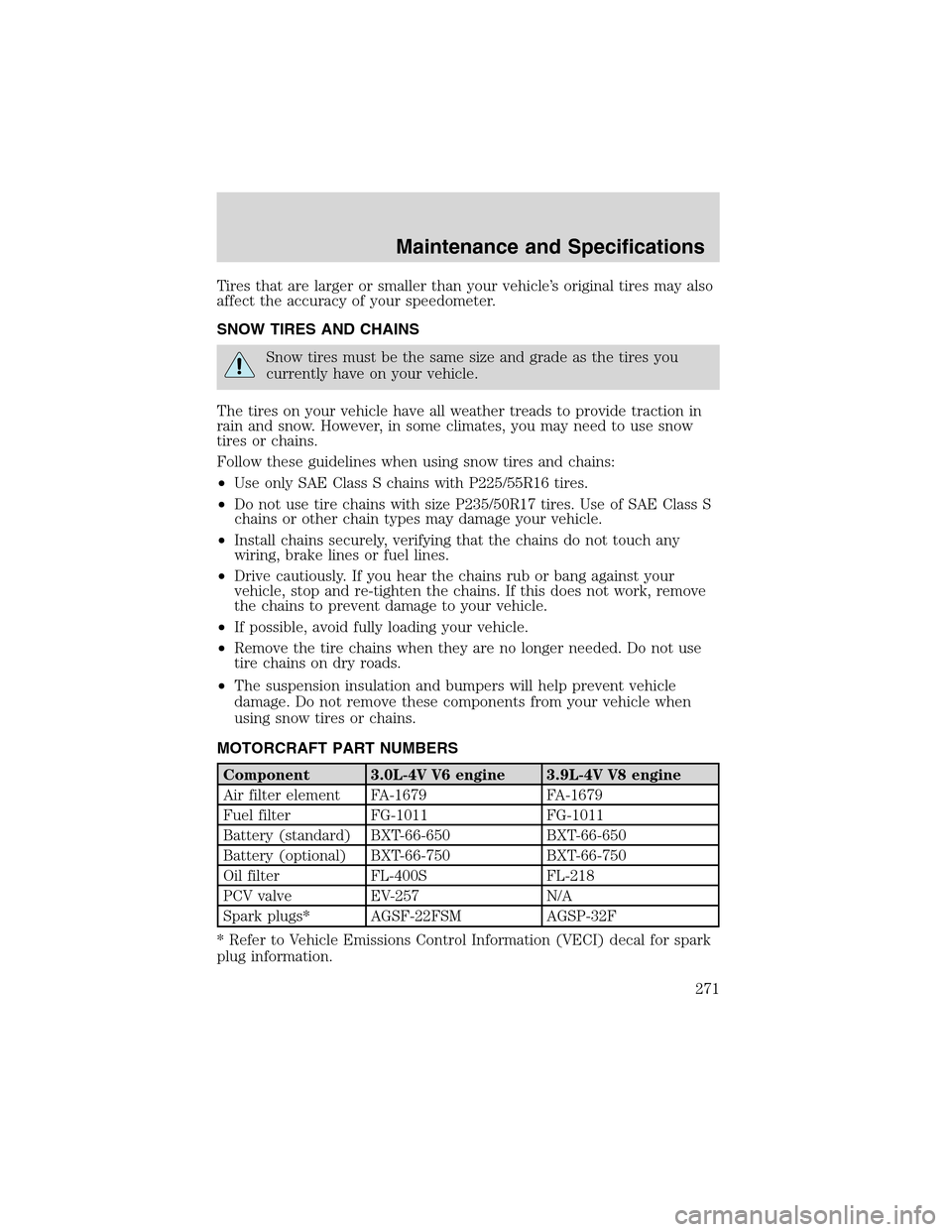Page 186 of 288

or APPLY ((P)). With the ignition on and the engine not running,
depress the brake pedal and apply the parking brake. The brake lamp
will illuminate; this is normal and the parking brake is now reset. To
release the parking brake, push the lever down with your foot on the
brake pedal.
STEERING
To prevent damage to the power steering system:
•Never hold the steering wheel at its furthest turning points (until it
stops) for more than a few seconds when the engine is running.
•Do not operate the vehicle with a low power steering pump fluid level
(below the MIN mark on the reservoir).
If the power steering system breaks down (or if the engine is turned
off), you can steer the vehicle manually, but it takes more effort.
If the steering wanders or pulls, check for:
•an improperly inflated tire
•uneven tire wear
•loose or worn suspension components
•loose or worn steering components
•improper steering alignment
Speed sensitive steering
The steering in your vehicle is speed sensitive. At high speeds, steering
assist will decrease to improve steering feel. At lower speeds,
maneuverability will be increased.
If the amount of effort required to steer your vehicle changes while
driving at a constant vehicle speed, have the power steering system
checked by your dealer or a qualified service technician.
TRACTION CONTROL�
Your vehicle may be equipped with a Traction Control�system. This
system helps you maintain the stability and steerability of your vehicle,
especially on slippery road surfaces such as snow- or ice-covered roads
and gravel roads. The system will allow your vehicle to make better use
of available traction in these conditions.
During Traction Control�operation, the traction control active light will
illuminate, you may hear an electric motor type of sound coming from
the engine compartment and the engine will not“rev-up”when you push
further on the accelerator. This is normal system behavior and should be
no reason for concern.
Driving
186
Page 189 of 288

enhancement feature; the brake portion of the traction enhancement
feature will still function normally. Pressing and holding the control for
more than five seconds will disable the AdvanceTrac�stability
enhancementandtraction enhancement feature. If the vehicle is stuck
in snow or mud or when driving in deep sand, switching off the
AdvanceTrac�system may be beneficial so the wheels are allowed to
spin. If your vehicle seems to lose engine power while driving in deep
sand or very deep snow, switching off the AdvanceTrac�stability
enhancement feature will restore full engine power and will enhance
momentum through the obstacle.
Some drivers may notice a slight movement of the brake pedal when the
AdvanceTrac�performs a system self-check. During AdvanceTrac�
operation you may experience the following:
•A rumble or grinding noise
•A slight deceleration of the vehicle
•The AdvanceTrac�indicator light will flash
•If your foot is on the brake pedal, you will feel a vibration in the
pedal.
•If the driving condition is severe and your foot is not on the brake, the
brake pedal will move to apply higher brake forces. You may also hear
a whoosh of air from under the instrument panel during this severe
condition.
All these conditions are normal during AdvanceTrac�operation.
Do not alter or modify your vehicle’s wheel/tire size, suspension
or steering; the resulting changes to the vehicle’s handling can
adversely affect the AdvanceTrac�system.
Modification/Addition of supplemental radio components, such as
a subwoofer, may adversely affect the performance of the
AdvanceTrac�system.
Aggressive driving in any road conditions can cause you to lose
control of your vehicle increasing the risk of severe personal
injury or property damage. The occurrence of an AdvanceTrac�event
is an indication that at least some of the tires have exceeded their
ability to grip the road; this may lead to an increased risk of loss of
vehicle control, vehicle rollover, personal injury and death. If you
experience a severe road event, SLOW DOWN.
Driving
189
Page 271 of 288

Tires that are larger or smaller than your vehicle’s original tires may also
affect the accuracy of your speedometer.
SNOW TIRES AND CHAINS
Snow tires must be the same size and grade as the tires you
currently have on your vehicle.
The tires on your vehicle have all weather treads to provide traction in
rain and snow. However, in some climates, you may need to use snow
tires or chains.
Follow these guidelines when using snow tires and chains:
•Use only SAE Class S chains with P225/55R16 tires.
•Do not use tire chains with size P235/50R17 tires. Use of SAE Class S
chains or other chain types may damage your vehicle.
•Install chains securely, verifying that the chains do not touch any
wiring, brake lines or fuel lines.
•Drive cautiously. If you hear the chains rub or bang against your
vehicle, stop and re-tighten the chains. If this does not work, remove
the chains to prevent damage to your vehicle.
•If possible, avoid fully loading your vehicle.
•Remove the tire chains when they are no longer needed. Do not use
tire chains on dry roads.
•The suspension insulation and bumpers will help prevent vehicle
damage. Do not remove these components from your vehicle when
using snow tires or chains.
MOTORCRAFT PART NUMBERS
Component 3.0L-4V V6 engine 3.9L-4V V8 engine
Air filter element FA-1679 FA-1679
Fuel filter FG-1011 FG-1011
Battery (standard) BXT-66-650 BXT-66-650
Battery (optional) BXT-66-750 BXT-66-750
Oil filter FL-400S FL-218
PCV valve EV-257 N/A
Spark plugs* AGSF-22FSM AGSP-32F
* Refer to Vehicle Emissions Control Information (VECI) decal for spark
plug information.
Maintenance and Specifications
271